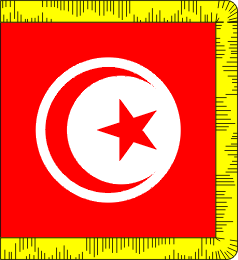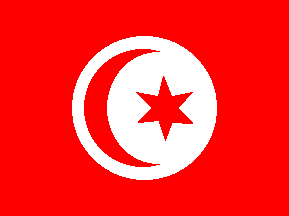 image by Željko Heimer
image by Željko Heimer
Last modified: 2012-10-06 by rob raeside
Keywords: tunisia |
Links: FOTW homepage |
search |
disclaimer and copyright |
write us |
mirrors
See also:
I show the image here with a large disk as in Album
des Pavillons (2000), though if the fringe is correct, the disk is probably
not, and should match the "usual" size. This (or better the white fringed
variant that I'll show subsequently) was adopted earliest on 25 July 1957 when
Tunisia became a republic and Habib Bourguiba became president. It may be
possible that it was abandoned on 07 November 1987 when Zine El Abidine Ben Ali
replaced Bourguiba as president. To speculate further, the yellow fringed flag
might have been a version used at first (shortly?) before the current "Li-l-watan"
flag was adopted. This would make the Tunisian Republic one of the several that
under French influence have habits of using different flags for subsequent
presidents. It may be too early for any conclusions, as we have only two
presidents to look at. Certainly, it wouldn't be surprising.
Željko Heimer, 12 April 2003
 image by Ivan Sache, 22 September 2012
image by Ivan Sache, 22 September 2012
On 14-15 September 2012, a public debate was organized at the National
Constituent Assembly (ANC), with the support of the United Nations Development
Programme (UNDP). The participants were given a notebook, whose cover was
printed with the Tunisian coat of arms (top left) and the Tunisian flag (top
right). It was soon noticed that the representation of the Tunisian flag was
erroneous, the five-pointed star being replaced by a six-pointed star. The
blunder was disseminated through different media, which started a small crisis,
amplified by some cranks who claimed that the Tunisian star had been replaced by
a Magen David as a prelude to the "establishment of the 6th caliphate" and to
the "normalization with the Zionist State".
Mustapha Ben Jaafar,
President of the ANC and member of the ruling party Ennahda, ordered to track
the source of the "monumental" mistake. Since nobody among the organizers,
especially the Ennahda party, had noticed the blunder, Ben Jaafar attempted to
put the blame on the UNDP. The reports of the reply by the UNDP differ among the
sources: they seem to have admitted that they had commissioned a printer to
prepare the notebooks and forgot to check the documents before distribution.
Several bloggers insisted that such a big mistake could be only deliberate.
However, we are ware of several flag blunders caused by lack of attention or
competence. Moreover, other bloggers recalled that the star represented on the
erroneous flag was not shaped as a Magen David. Had it been, it would not
necessarily be the mark of a Zionist plot; some recalled that similarly shaped
symbols are very common in the Islamic iconography. Finally, some commentators
argued that Tunisia faced much more serious challenges than this flag issue and
that the UNDP was a main support of the set up of democracy and should not be
blamed for such a minor issue
To conclude, this odd rendition of the flag
appears as a circumstantial mistake, amplified by the Tunisian political
context. Moreover, there is not the least evidence of any plot of any kind to
change the Tunisian flag - a few, more or less serious proposals to change the
colour of the flag or to add Islamic writing have been quickly rejected. The
erroneous design appeared on a few hundreds of printed documents and nowhere
else; there is no report of such a flag in the cloth - which does not mean that
some prank will not produce one copy of it.
http://www.radioexpressfm.com/album/show/l-etoile-du-drapeau-tunisien-avec-6-branches
- Photos of the notebook
Several reports identified the emblem on top left
corner as the "logo of the ANC", while it is the national coat of arms, adding a
mistake to the report of the mistake. This casts some doubt on the accuracy of
their further comments on the "origin" and "meaning" of the six-pointed star.
The website of the ANC shows the flag of
Tunisia with a five-pointed star. However, the details of the design do not
match the specifications adopted in 2000>)
Ivan
Sache, 22 September 2012